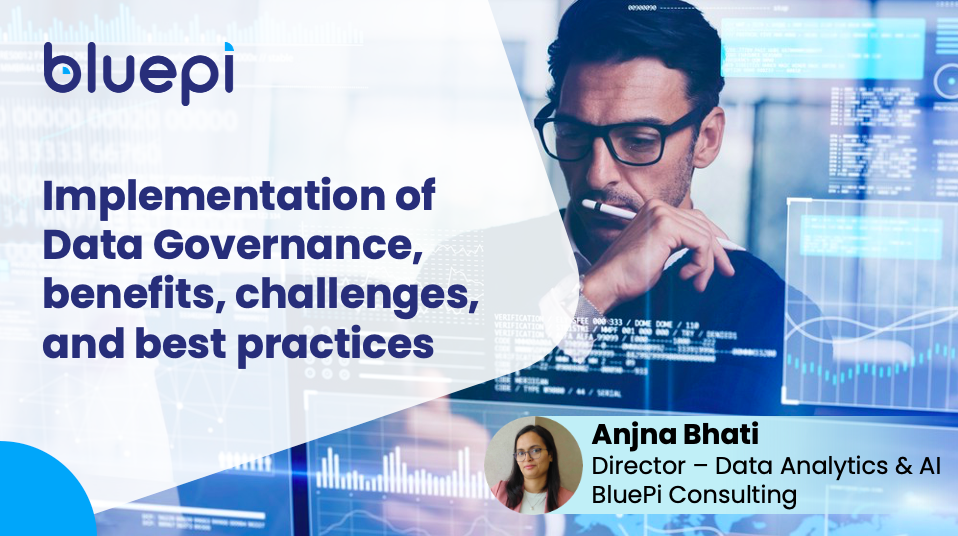Implementation of Data Governance, benefits, challenges, and best practices - Anjna Bhati, Director - Data Analytics & AI, BluePi Consulting

New-age technologies and digitalization are certainly driving economic
growth across the globe and enhancing the lives of individuals. For the long-term and sustainable development
of the organization, digital strategies and data governance have to be inclusive.
Businesses have to manage data by reducing its complexities and extracting maximum value from it. They also have to be able to manage risks and ensure compliance with all regulatory requirements to optimize business operations and drive business decision-making.
Data governance is the core component of any organization’s data management strategy. Good data governance enables better management of data which is leveraged for Business Intelligence and analytics. Organizations require this program for the successful implementation of digital transformation, business processes, and risk management, among others. In the current context where data is extensively used for wider applications with the help of new-age technologies, data governance is a crucial component. However, business and IT leaders have to lay more emphasis on the business benefits of the governance program for it to succeed.
A well-designed data governance program
This consists of a data governance committee, data stewards, business and data management professionals, a Chief Data Officer, Data Quality Analysts, and Engineers. This team establishes Standards and Policies governing data as well as the implementation of the program. Today in different business units at several organizations, data exists in silos and is inconsistent. Hence, all business units have to work towards common data definitions to understand it and improve its quality. It is also crucial to ensure the accuracy of data analytics for better decision-making. Businesses have to implement policies for better data management and also ensure compliance with data privacy laws. For achieving this, sensitive data should be secured across data storage, processes, and during transmission.
A good data governance program consists of
key elements such as a data governance team, enterprise original structure,
data strategy, relevant processes, rules and policies, data security,
technology stack, and key performance indicators.
The governance framework has to be documented and shared internally so all employees involved will have clarity about the program and its functioning.
Implementation of data governance
At the outset, it is important to define data governance goals and objectives before establishing roles and responsibilities for collecting, storing, and using data. As a strategic initiative, it is important for the organization to know about the data that exists in the organization by identifying, classifying, and managing datasets with active metadata management and data catalogs.
Then the metadata has to be centralized by choosing the right storage option. This will deliver the scalability and flexibility required for data analytics. The next process is to reformat and rectify raw metadata so that all the data is easily understood and leveraged across the organization. The datasets have to be combined into data catalogs. Then comes building a governance model that is customized based on the organization’s needs and it should provide flexibility and encourage innovation. Data governance policies must be incorporated into employees’ workflows, tools, and day-to-day activities to be made effective. All potential risks should be identified. Employees should be provided access to data when required only and all sensitive data locations should have security controls in place.
Then the data governance plan can be rolled out before the execution of change management. Most importantly there should be an ongoing evaluation of the data governance framework.
Common data governance challenges
Many a time different business units have diverging views of the data without the data definitions and formats. Showcasing and demonstrating the business value, getting approval for a data governance program from the senior management, and ensuring it gets funded may be difficult. Siloed data without one common source of truth and available information will be a challenge to analyze and come up with meaningful conclusions. Sometimes organizations spend time and resources collecting data that is not related to the business objectives. This poor quality of the data without ownership and proper context is a wasteful activity. Poor leadership and incorrect allocation of resources are other data governance challenges.
Best practices for data governance management
To make certain that the data governance program is wholeheartedly accepted by the leadership team and all business units, it is important to deploy well-experienced data governance managers and industry consultants. They will ensure the program supports meeting the business objectives of the organization as well.
The data governance strategy must be
customized to suit the organization’s requirements and objectives. The focus of
the initiatives should be on the business value. It is important to consider
data as a strategic resource and identify all the critical data components at
the initial stage itself. The data governance team has to create policies and
relevant procedures for the entire data lifecycle and there should be an
encouragement for broader participation and team collaboration. The C-Suite has
to be actively involved in the governance procedures and there should not be
over-restrictions on the use of data by the employees. Ongoing education and training should be
mandatory in addition to putting in place the measurements for the
effectiveness of the data governance program.



